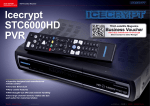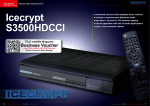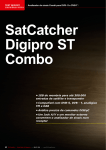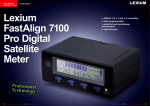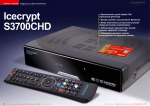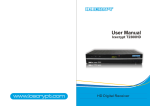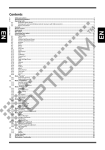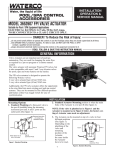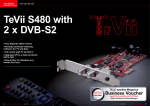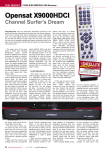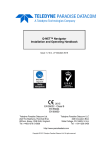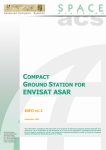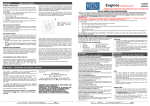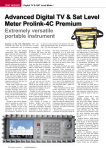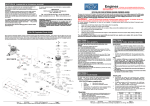Download Icecrypt S3000HDCCI
Transcript
TEST REPORT 该独家报道由技术专家所作 HDTV Satellite Receiver Icecrypt S3000HDCCI •Extremely fast blind scan that can find low SR channels •Supports a wide variety of CA systems •Built-in multi satellite controls (USALS) let the box find every channel on your multi satellite system automatically •Full PVR features via USB GUARANTEE direct contact TELE-satellite Magazine Business Voucher www.TELE-satellite.info/11/09/icecrypt Direct Contact to Sales Manager 16 TELE-satellite — Global Digital TV Magazine — 08-09/2011 — www.TELE-satellite.com www.TELE-satellite.com — 08-09/2011 — TELE-satellite — Global Digital TV Magazine 17 TEST REPORT HDTV Satellite Receiver Master 08-09/2011 Icecrypt S3000HDCCI Super fast blindscan finds all channels of Blind Scan The term “well rounded” comes to mind when studying the specifications of this receiver. Although it has only one tuner and not that many interfaces as you might find in top-of-theline models, all the main functions and features of a PVR-type satellite receiver are there. But how does it perform? Is it fast enough? Is its software stable and are its submenus logically organized and easy to follow? Will it be good for family use or is this more a model for a satellite enthusiast? Our TELE-satellite test gives clear answers to these questions and other ones like that. Its elegant black design pleases the eye. We especially liked the eight-character 14-segment green display mounted on the left hand side of the front panel. Also the labels for the eight front panel buttons look great. On the right side of the front panel is a flap behind which we can find the USB 2.0 port, a smart card slot and a CI slot. The smart card reader is described in the specifications as compatible with Conax but it is in fact a uni- 1 versal one. We confirmed in our tests that it can work with smart cards of at least two other CA systems: Viaccess and SECA. The rear panel has everything you expect from a single tuner box: LNB input and looped-through output, digital outputs: HDMI and optical S/PDIF audio, analog outputs: 2 x SCART, 6 x RCA with composite, component video and stereo audio, data interfaces: Ethernet and RS-232 and a main power switch. The USB port is not duplicated on the rear panel – so when you connect a memory device you have to keep the flap open on the front panel. In our opinion the remote control unit does not look as elegant as the box. It’s a puzzling thing: why does the design of a remote control often have no resemblance to the design of the box? That’s a fact for quite a few A/V devices. It would be great if you could look at several remote controls spread out on a table and be able to instantly match the remote control with the receiver simply by comparing its appearance to that of the receiver. The S3000HDCCCI does not have an installation assistant. Right after powering up the unit, you are taken to the main menu. Navigation in the menu is simple and fast. The menu consists of six submenus: Edit Channel, Installation, System Setup, Tools, Game and REC. It would help to have some experience with satellite TV receivers in order to install the S3000HDCCI properly. We’ll describe this process a little to assist our less experienced readers. The first and most obvious step is to set the OSD language so that you can understand all the menu items. By pressing the down arrow button twice in the Main Menu, the System Setup submenu is shown. A push of the OK button takes you to the right hand side of the menu and the Language submenu is highlighted. After pressing the OK button again, the content of this menu is displayed. You can choose from the following language options: English, French, German, Italian, Spanish, Portuguese, Russian, Turkish, Polish, Ara- 2 18 TELE-satellite — Global Digital TV Magazine — 08-09/2011 — www.TELE-satellite.com bic, Dutch, Czech, Slovak, Greek and Hungarian. Not only can the OSD language be set here but you can also select the preferred audio language (first and second) as well as the preferred teletext language. When a new channel is selected, the S3000HDCCI will always try to connect to the soundtrack in the language that was selected as the first audio. If it’s not available, it will try to find the second audio and only if the second preferred audio is not available will it connect to the first available soundtrack of a given channel. Now that a proper OSD language has been chosen, the next step would be setting up the TV system, which can be found in another submenu in Systems Setup. If you are using an HDMI connection and your TV supports 1080i resolution, we suggest setting this value as the Video Resolution in the receiver’s submenu. We also suggest leaving the other menu items in their default settings (Aspect Mode = Auto, Video Output = YUV, etc.). You can adjust them later if necessary. The next submenu you should visit is the Local Time Settings where you tell the receiver what your local time is with respect to Greenwich Mean Time (UTC). You can also configure the S3000HDCCI to automatically adjust the receiver’s time to daylight savings time if this is in use in your country. At this point you’ll want to match the antenna system connected to the LNB IN jack to the receiver. This 3 0.4 7 can be taken care of in the Installation Menu. From the Antenna Connection menu you have two options: Fixed Antenna and Motor Antenna. If it’s a simple installation, you would choose the Fixed Antenna option. In the next submenu you can identify which satellites you want to receive with your dish. Depending on the settings in these two menus, the third menu item – Antenna Setup – gives you an opportunity to set up your reception system in more detail. The LOF frequencies have to be chosen from the list – they cannot be entered manually. Fortunately, there’s no need to worry, the list is quite extensive. It contains the following frequencies: 5150, 5750, 5950, 9750, 10000, 10050, 10450, 10600, 10700, 11250, 11300, 5150-5750, 5750-5150, Universal (9750-10550), Universal (9750-10600), Universal (9750-10700) and Universal (9750-10750). By default the most popular choice in Europe for the Ku-Band is Universal (9750-10600). These settings must match your LNB LOFs. Depending on the type of antenna you have, there are different DiSEqC op- tions available. For a fixed antenna, you can select between DiSEqC 1.0, 1.1 or no DiSEqC (= direct). If you have just one LNB and do not use any DiSEqC switches between your receiver and the LNB, then ‘no DiSEqC’ is the proper choice. For a motorized antenna, you can select either DiSEqC 1.2 or USALS depending on the type of motor you have. If USALS is se1. Edit Channel 2. Installation submenu 3. System Setup submenu 4. Tools submenu 4 www.TELE-satellite.com — 08-09/2011 — TELE-satellite — Global Digital TV Magazine 19 5 6 7 8 9 lected, you must enter the geographical coordinates of the antenna’s position. All of this is fairly logical. Once the antenna setup is completed, you can move on to channel searching. We can search either one satellite or a number of satellites in a single pass. Of course, the latter is possible if motorized or multi feed antenna systems are in use. The factory preprogrammed satellite list is not very long and has only 41 positions. Some important satellites for the European market are missing – for example, HELLAS SAT at 39° east is not in the list. However, as you will see, this is not a big problem at all. We started with an automatic scan of the HOTBIRD satellite at 13° east. The S3000HDCCI required almost 7 minutes to scan 92 factory preprogrammed transponders; this is fairly good. 1239 TV channels and 357 radio channels were found. After resetting the box and turning on the Network Search option, the scan was repeated. This time it took 8 minutes and 45 seconds but the number of channels grew significantly: 1510 TV channels and 418 radio channels. But here’s the best part: as the proud owner of an S3000HDCCI, you can opt for yet another option – a blind scan. We couldn’t wait to test it. There are no options to be set for this kind of a scan (like frequency range or polarization) so you just select blind scan and let the box take care of the rest. We expected 5. Three video games are available 6. REC submenu to configure a USB memory device 7. Satellite List 8. Setting up a USALS compatible motorized antenna 9. Ready for scanning one satellite - HOTBIRD 13 E 20 TELE-satellite — Global Digital TV Magazine — 08-09/2011 — www.TELE-satellite.com the blind scan to take much longer then the automatic scans based on the preprogrammed transponder lists. But we were shocked when the box reported the end of the process after only 5 minutes and 15 seconds. It found 98 transponders, 1485 TV channels and 417 radio channels. That’s an outstanding result and far better than we expected! As mentioned before, the HELLAS SAT was missing from the satellite list. Keeping in mind the results from the HOTBIRD scans, we decided to add the HELLAS SAT channels using the blind scan feature and not the automatic scan because this would have required us to manually enter in a number of transponders. Within just a couple of minutes the blind scan was finished; it found 27 transponders and 231 TV channels. For this test we were looking only for TV channels and noticed that not only high symbol rate transponders were detected and processed but SCPC transponders as well – for example 11139 MHz V with a symbolrate of 2.891 Ms/sec. Considering that the blind scan was so successful, we decided to perform the installation as if we were doing it for our own home receiver. We deleted all of the factory preprogrammed satellites and entered only the satellites that can be received at our location with a 90 cm motorized dish. That turned out to be 25 satellites – from HISPASAT at 30° west to INTELSAT 12 at 45° east. The blind scan’s job was to find all the FTA TV and radio channels on these satellites and we started it in the Multi Satellite Search submenu. After leaving the box unattended for about two and half hours, we dis- 10 11 15 16 20 21 covered that the scan had finished and the receiver’s channel list was filled up. We counted 2437 FTA TV channels and 1854 FTA radio channels. Since the box has a memory capacity of 5000 channels, there were still over 700 unoccupied channels. They could be used for PayTV channels. Among the channels found we noticed there were quite a number of SCPC transmissions, like: SOLIDARIA on HISPASAT (SR=2.222 Ms/sec), RIT on ATLANTIC BIRD 1 (SR=2.139 Ms/sec) or ISHTARFEED A on ATLAN- TIC BIRD 2 (SR=2.098 Ms/ sec). Generally all symbol rates were present from the very high (30 Ms/sec), through medium (4-6 Ms/ sec) to the very low (around 2 Ms/sec). This means that the blind scan function of this receiver is very scrupulous in detecting all active transponders. The receiver tuner also detected and correctly processed the weaker transponders which would occasionally produce some glitches when viewed with other receivers. All in all, we were very pleased with the performance of the blind scan function in 10, 11. Automatic channel scan in progress 12. Signal strength and quality of a transponder 13. Othello is a simple but addictive game 14. Info bar 15. Electronic Program Guide 16. The Find function helps you find a channel in a long channel list 17. Switching soundtracks 18. Extended channel description 19. Teletext displayed as OSD 20, 21. Timeshift function 22. SD channel video zoomed 12 times; maximum zoom is 16x 23. Media player ready to show JPG pictures 24. Mosaic of JPG pictures 25. The S3000HDCCI is ready to play back an MPG movie stored on a USB device 26. List of recordings 12 17 22 13 18 23 25 14 19 24 26 22 TELE-satellite — Global Digital TV Magazine — 08-09/2011 — www.TELE-satellite.com www.TELE-satellite.com — 08-09/2011 — TELE-satellite — Global Digital TV Magazine 23 27 28 29 30 31 the S3000HDCCI as well as the sensitivity of its tuner. We heartily recommend using the blind scan option for channel searching. With the channel search portion complete, the S3000HDCCI took us to the very last channel it had found. We could now start enjoying watching TV. The time to switch between channels was very short – one second or slightly above one second. Channel surfing was a real joy. The info bar appeared momentarily after each channel change and displayed typical data: channel name and number, current and upcoming program and icons identifying channel features like scrambling or the presence of EPG data. The info bar can be displayed at any time when watching TV by pressing the Info button. Pressing the Info button again displays more information about the channel and the transponder – including signal strength and signal quality. To see extended programming descriptions, you have to visit the EPG screen. The EPG has only one format - grid form but it’s probably the most desired one. It shows the programming guide for channels transmitted within the current transponder. If you highlight the program you are interested in and press OK, its extended description is shown. Of course, this is only true if the provider makes this information available. You can mark the programs to be recorded directly in the EPG. Up to eight timer settings are allowed. 27. Organizing channels 28. Transponder editor 29. Channel info bar 30. Electronic Program Guide 31. Programming a new recording in the EPG 24 TELE-satellite — Global Digital TV Magazine — 08-09/2011 — www.TELE-satellite.com The S3000HDCCI comes with channel editing functions that are quite straightforward to use. You can do everything that you normally would expect from a channel editor, such as, locking a channel with a PIN, setting a channel to be skipped during channel surfing with the PR+ and PR- buttons, moving a channel within the channel list, deleting a channel or renaming it. You can also sort channels in a number of ways. When in the editor screen, the video of the currently selected channel is visible in an insert and information about the satellite, transponder and channel PIDs are also shown. The availability of 32 Favorites lists is a number that will satisfy every user. The S3000HDCCI allows you to name them as you wish. Simply enter the proper menu item and use the on-screen keyboard to change the name of the list. During normal viewing, the color function buttons can be used to change the soundtracks (if more than one are present), display teletext, change the video resolution of the HDMI signal or start the Find function. The Find function filters the channel list in accordance with the first several letters entered by the viewer. This is a very helpful feature when looking for a specific channel among hundreds or even thousands of others. The S3000HDCCI has PVR functionality. After connecting a USB storage device to its port, the box turns into a fully functional digital recorder. You can program a recording from the EPG, from the timer submenu or manually by pressing the RECORD button when watching a program. Every mode worked TECHNICAL DATA Manufacturer Icecrypt, Sittingbourne, United Kingdom Websitewww.icecrypt.com [email protected] Fax +44-1795 427 666 ModelS3000HDCCI Description Expert Opinion + perfectly in our tests. While recording, you can watch another channel from the same transponder but you cannot play a previously recorded program. This is only a minor limitation of this receiver. Even when recording and watching another channel at same time, you still can use the Timeshift function. The Timeshift function is started by pressing the PAUSE button. The picture freezes and everything from that moment on is recorded on a USB storage device. You can restart the video a little bit later by pressing the PLAY button. Similarly to normal playback of regular recordings, you can also rewind or fast forward a program when watching it in time shifted mode. This is an especially useful feature when viewing channels with lots of commercial breaks. The S3000HDCCI’s media player is not just limited to playing the receiver’s recordings; it will happily work with MP3 music or JPG/BMP images located on your USB storage device. When in slideshow mode, the media player can switch between 4 MB JPG files every 5 to 7 seconds. It’s not as fast as a regular PC but it’s much faster than older receivers. Video recordings in AVI and MPG formats stored on USB storage devices can also be played with the S3000HDCCI media player. However, be aware that some of the video file formats are not supported by this receiver. Fortunately, there are many free video converters available so you can convert the most important files to a format recognized by the S3000HDCCI. So the next time your aunt comes to visit, you can turn on your media player and show her all the videos and photos you took from your last vacation. If you do that in a clever way, chances are she won’t visit you again anytime soon. 26 TELE-satellite — Global Digital TV Magazine — 08-09/2011 — www.TELE-satellite.com If watching live channels, recordings, MP3’s or JPG’s are not enough, you can go to the Game submenu where you’ll find three video games: Tetris, Othello and Sudoku. The receiver’s software can be updated from the Internet either via the RS232 port or the USB port. The default settings for an Internet update didn’t work for us so we visited the manufacturer’s webpage and downloaded the latest firmware version for the S3000HDCCI. After uncompressing the file, we transferred it to a USB stick and connected it to the receiver’s USB port. The update process went smoothly - the receiver had programmed its internal memory, rebooted and – SCR CompatibleNo Excellent blind scan – very fast and accurate Supports smart cards of different CA systems Very fast channel surfing Extremely low energy consumption in stand-by Firmware update erases all user satellite and channel data the new firmware (version 2.10B4) was installed. Unfortunately, all our satellite and channel information disappeared. That was a surprise! Hopefully Icecrypt will address this issue as soon as possible; user data should not vanish like that. We suggest that you should start with updating the receiver’s software first before proceeding to receiver configuration and channel search. Throughout the entire test the S3000HDCCI performed very well and did not give us any hardware or software problems. We were able to figure out most of the receiver’s fea- Digital Satellite Receiver/ PVR ready C/Ku Band CompatibleYes DiSEqC Compatible 1.0 – 1.3 (USALS) PVR readyyes Jacek Pawlowski TELE-satellite Test Center Poland tures and functions without any reference to the user manual. The manual explains all of its major functions, comes with numerous screenshots and will confidently guide you through the receiver’s installation even if you happen to be new at this sort of thing. This receiver is suitable for family use as well as for both single and multisatellite reception systems. It is obviously limited by its single tuner unit but if you can live without the ability to record one channel while watching another from a different transponder, you should be very happy with the S3000HDCCI. Input 1 x L-Band (950-2150 MHz), LNB power 13/18VDC, max.400mA , SCPC Compatible Yes (from 2 Ms/sec) Transport Stream MPEG-II ISO/IEC 13818-2 MP@ML, H.264 MPEG4 part 10 Audio Decoding MPEG-1 Layer I & II, PCM Downmix, IEC958 SPDIF, Dolby 5.1 channel, Dolby Downmix 2 Channel, Dolby Prologic 2 Main Processor ALI 3602 Memory Flash-ROM : 4 MBytes SDRAM 64 Mbytes Power Supply AC 175 ~ 250, 50/60Hz Size (W x H x D) 260mm x 45mm x 213mm ENERGY DIAGRAM Apparent Power Active Power Mode Active StandBy www.TELE-satellite.com — 08-09/2011 — Apparent Active Factor 36 W 17 W 0.47 4W 0.5 W 0.12 TELE-satellite — Global Digital TV Magazine 27






